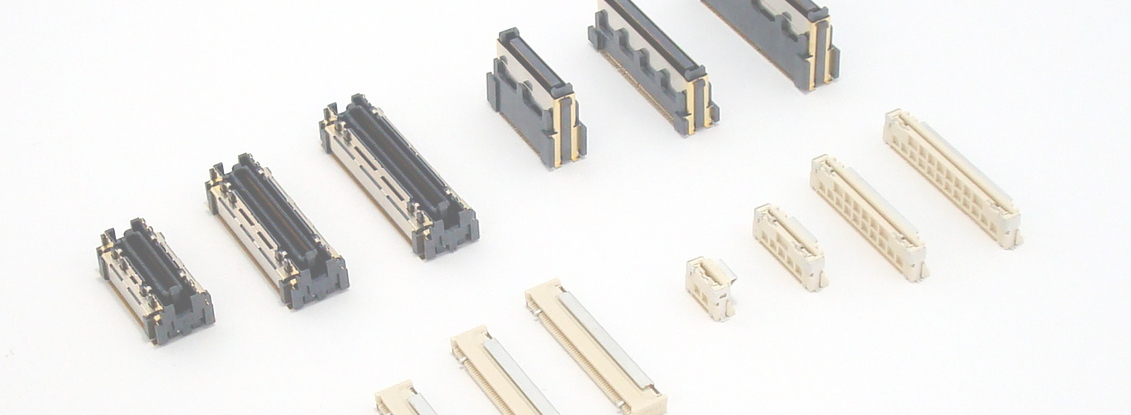

- Top
- Technical Info
- What is a connector
- Options to improve connector reliability
2-point contact connector
What is a two-point contact?
コネクタの接続信頼性を上げるオプションとして2点(もしくは多点)接点と言う物があり、様々な構造が考案されています。その名の通り1つの接続に対して「2点」の接点を持つコネクタで、「どちらか片方でも繋がっていればOK」=すなわち冗長接続を実現する技術です。これによって、嵌合時のトラブルや振動による瞬断等のリスクを低減します。また、ある特定の構造条件を満たすことで異物除去の効果を持たせる事も可能です。一方で、弱点と言いますか2点接点としての課題も存在します。これに関する内容は「コネクタとは」でも少し触れていますが、ここではもう少し詳しく説明していきます。
Main two-point contact structure
As mentioned above, various structures have been devised for two-point contacts and are on the market, but they can be roughly divided into four types.
(1) Vertically aligned contacts
(2) Contacts lined up horizontally = Broken object
(3) A structure in which the male contact (plug) is sandwiched between the female contact (Socket)
(4) Each has a contact point and each is combined to form a two-point contact point.
Various two-point (multi-point) contact structures can be said to be largely derived from these four.
for example coaxial connector, etc. can also be regarded as multi-point contacts in 360° rotation, but this can also be said to be a derivative of ③.
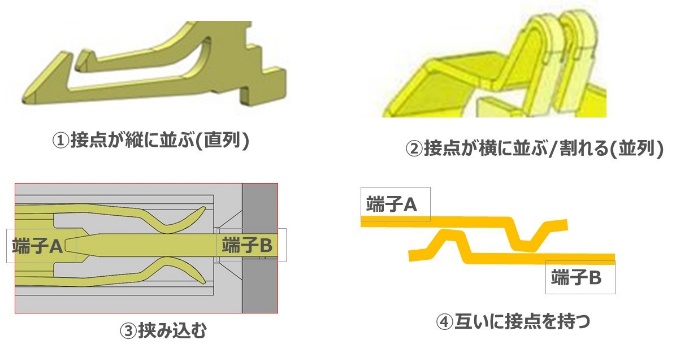
Conditions for Properly Providing Redundant Connections
In order to provide redundant connections, any of the four structures in the previous section must be "spring independent". The figure on the right is an example of a very simple diagram of a foreign object running on top of the contact. I'm here. This is not only due to interference with Mating due to foreign matter. For example, if the two contacts move synchronously due to momentary disconnection due to vibration, connection redundancy cannot be expected.

In terms of (1) to (4) in the previous section, (3) and (4) would not hold if the springs were not independent in the first place. When the spring is not independent on one side (1) or (2), for example, it is an effect when there is a local defect on the other side, or it is a wiping effect ((1)) against soft foreign matter, or an ejection mechanism such as a tire groove. It may be possible to improve reliability in terms of (2), etc., but it is necessary to have independent springs to ensure accurate redundant connections. In principle, all 2-point contacts provided by IRISO have independent springs.
例えば、あまり他にないですが、コンプレッションターミナルにおいても独立バネの2点接点を有したタイプの提供もしています。
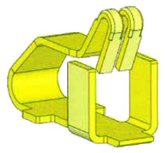
Series 2-point contact effective for foreign matter removal
こちらは「コネクタとは」と重複する内容となります。下の動画を再生いただくと一目瞭然ですが、直列タイプの2点接点には異物をワイピングする効果があります。この効果が期待できるのは前々項での①~④の部類中の①の直列タイプのみです。イリソでは2点接点採用時には、この異物除去効果に重きを置いており、直列タイプをメインとしています。実際に多くのお客様での異物による嵌合トラブルの改善に貢献しています。
Issues with 2-point contacts: Compatibility with high-speed transmission
それでは2点接点は万能なのかと言うと、難しい側面があるのも事実です。それは高速伝送との親和性の課題です。一つは端子形状が複雑になるのでインピーダンスマッチングの確保が難しくなると言う点です(課題①)。これについては、もう少し詳しい内容をイリソテクニカルノート「『フローティング』と『高速伝送』は相反する要求?」の方でもしていますので、興味のある方はご参照ください。
Another problem, which is more serious if it occurs, is that even if the initial characteristics are good, "performance will not be obtained if one side of the two-point contact comes off" (challenge 2). The contact on the detached side becomes a state called a "stub", where the high-frequency signal resonates, making it impossible to maintain sound transmission. Redundancy should have been ensured by having two points of contact, but if it goes beyond a certain area, it will actually "take on more risks".
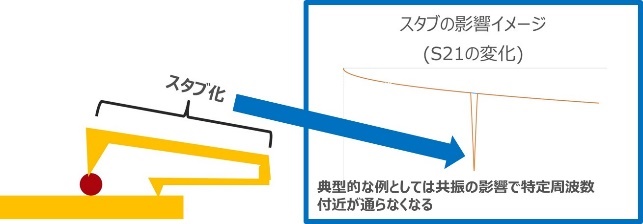
There is also the difficulty that this cannot be detected, for example, in a DC/low frequency signal inspection at the time of equipment start-up. Although it depends on the size of the connector and the specific design, these problems become noticeable, but there seems to be an example where they become apparent after exceeding 10 Gbps. Such phenomena on the high-frequency side are difficult to reproduce through actual verification, so risks can be reduced by performing advance verification such as confirming changes in performance when one side is detached by electromagnetic field simulation. On the other hand, if it is a "high-speed transmission" with a lower rate to some extent, we can expect improved reliability (Fig.). In the first place, a detailed design is necessary to bring the solution of issue (1) to this area, so it is also a problem that is currently manifesting only in limited places.
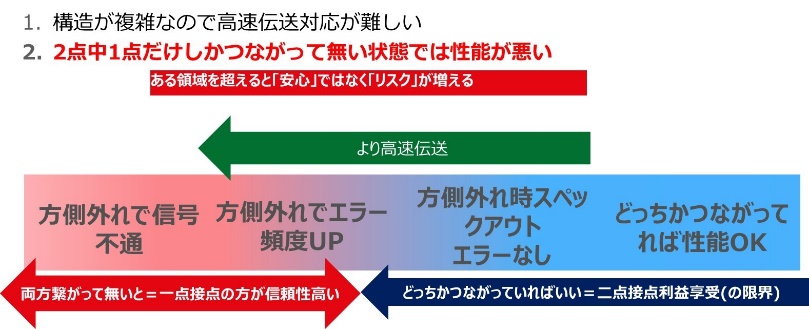
Currently, IRISO products have not released a two-point contact connector in the area where this problem becomes apparent (10 Gbps or higher), but IRISO will not give up on future products that overcome all of these issues. Hmm. However, there are ways to improve reliability other than the two-point contact method, so if you are considering compatibility between connection stability and high-speed transmission, please contact us first.
Electrostatic shield/ GND
What is an electrostatic shield?
Roughly speaking, an electrostatic shield is a method of enclosing an object through which an electrical signal flows with a metallic body. When an electric current flows in a certain place, something called an induced current flows in the nearby metal (conductor) in the opposite direction to the current that caused it. The fact that an electric current is flowing means that an electromagnetic field is generated around the electric current. increase. Therefore, an electrostatic shield is a shield that surrounds an electronic device or part with a metal body to cancel out the electromagnetic field generated from inside, that is, noise. This has the same effect on noise coming in from outside. This includes metal housings of various devices and shields applied to electric wires, and shield products on bags that wrap them are also seen on the market.
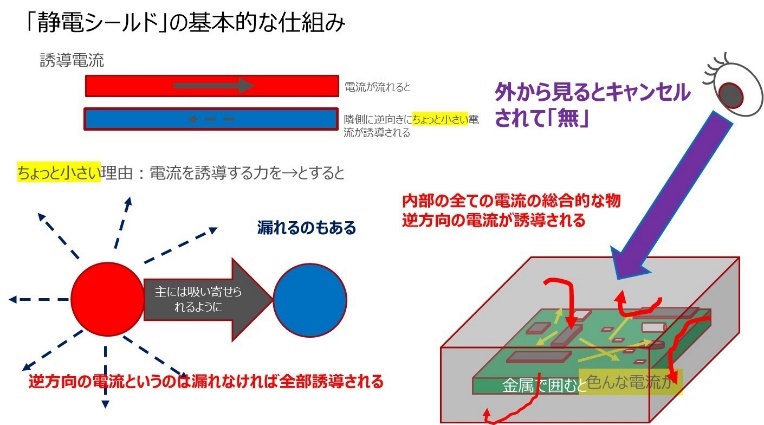
Connector electrostatic shield
Connectors are also attached to various products in the form of metal shells. IRISO has also released shielded Board to Board Connector connectors. It is also effective in differential transmission, but it is relatively less effective in differential transmission because the electric field tends to be closed due to the phenomenon called "coupling" in the line, but it is more effective in single-ended transmission where the electric field tends to diverge. will demonstrate.
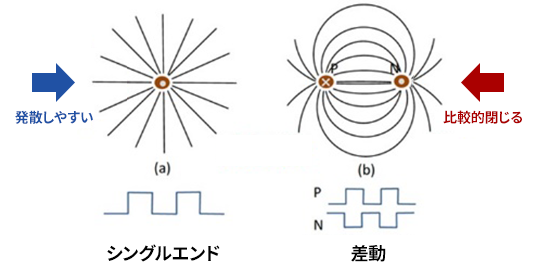
The problem of gaps in electrostatic shields
By the way, there is a problem that bothers us as a connector manufacturer. It's a question of how to manage shield gaps. Such in-machine connection type connectors inevitably have gaps in the shield, especially in SMT mounting, because they are mounted on the board. In particular, if you want to perform a visual inspection of soldering conditions (fillets, etc.) without using X-rays, etc., it is necessary to secure a large area. Leakage of the electromagnetic field occurs from this gap, and especially the shorter the wavelength, the higher the frequency, the narrower the gap, so the effectiveness of the electrostatic shield may be lost in the first place. In such a situation, it may be better to use the cost of shielding individual parts for other countermeasures (additional countermeasure parts, etc.). On the other hand, if it is combined with a connection form such as BGA or press-fit, this gap can be made smaller, and gimmicks that cover up even SMT types have been devised/commercialized. These options should be considered while matching with the actual customer's manufacturing process and expected cost. In addition, it is necessary to consider whether it is necessary to improve the EMC characteristics of the entire device, or whether it is necessary to take countermeasures against self-poisoning (including interference with wireless modules, etc.).
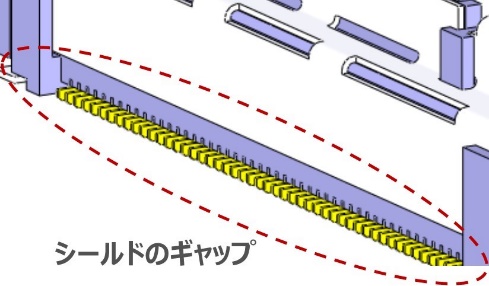
grand terminal
A ground terminal is a terminal for grounding/connecting an electrostatic shield, etc. The figure on the right is the terminal for grounding the electrostatic shield (tape) of the FFC to the board through the connector. As an option for this, there is a connector with the option of increasing the number of multi-point contacts = ground terminals (customized product). This reduces the ground resistance and is actually effective for some customers.
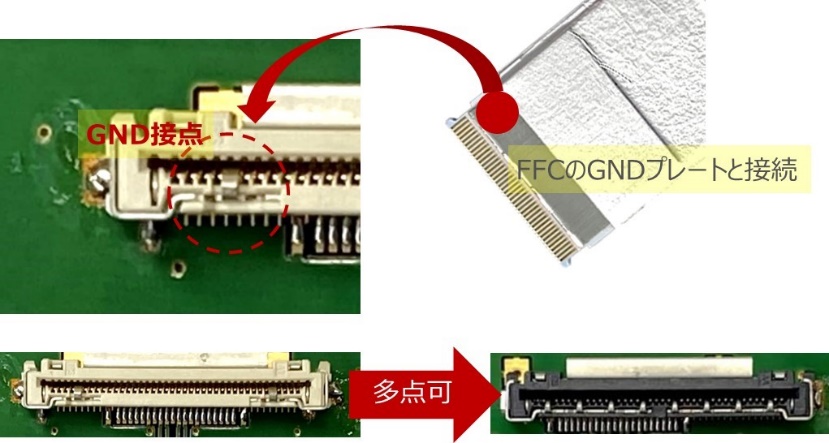
The dimple structure seen in the Mating part of the metal shell of the I/O cable (although it is not commercialized by our company) has the same purpose, and is applied for the purpose of reducing the ground resistance of the shield and increasing the shield effect. increase. In addition to the gap problem mentioned earlier, how to ground with low resistance is also a factor that determines the performance of the electrostatic shield.
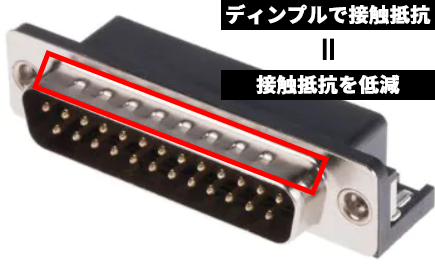
Electrostatic shielding is a very good and relatively inexpensive countermeasure in areas where it is expected to be effective. Regarding the effects of EMC and electrostatic shielding, it is difficult to conduct a quantitative evaluation close to the actual situation for each individual component. Therefore, IRISO has accumulated know-how based on customer feedback and evaluations that combine methods such as electromagnetic field analysis and next-proximity measurement. I'm here. We will work on solving the above issues and continue our daily development to raise the "reliability improvement" brought about by the electrostatic shield to an even higher level.

